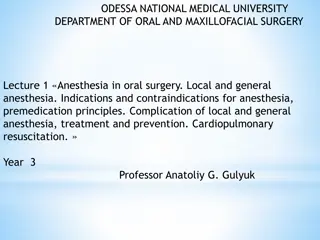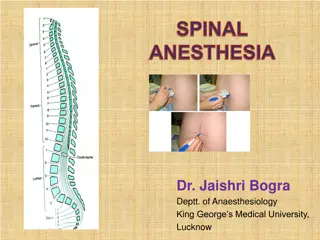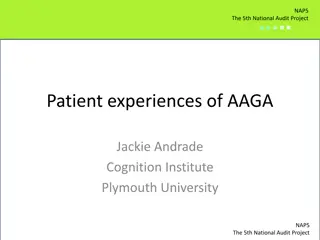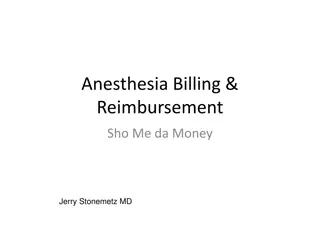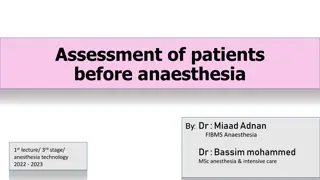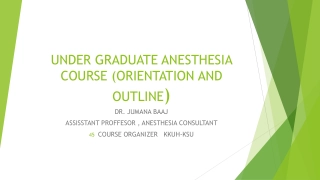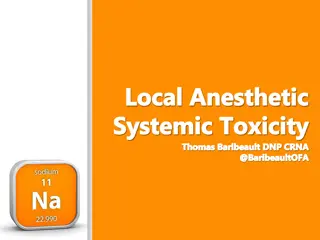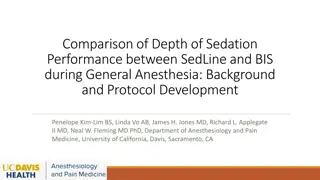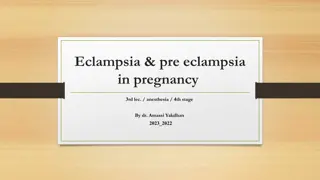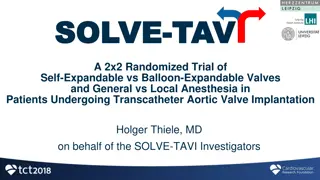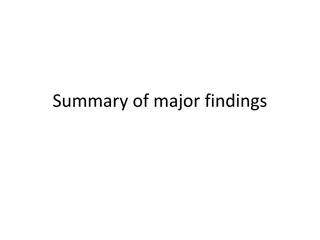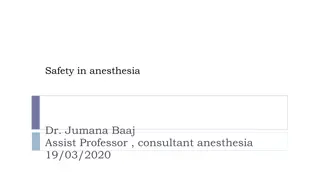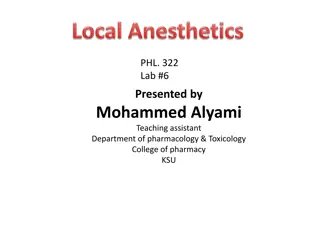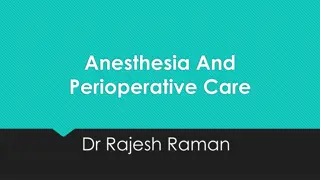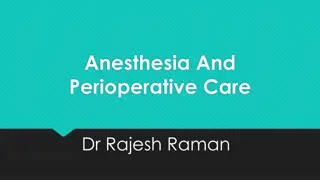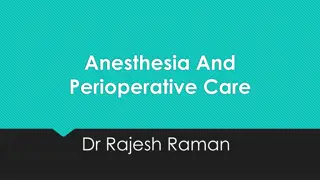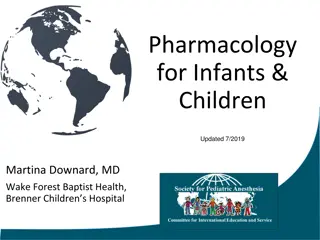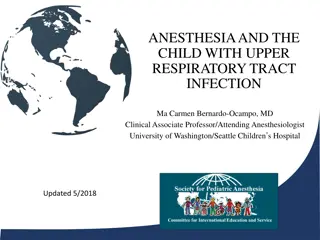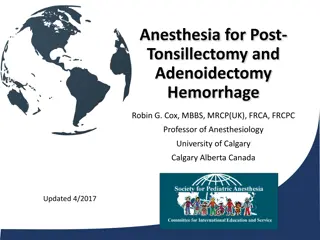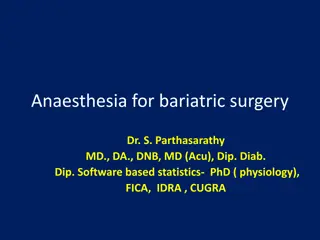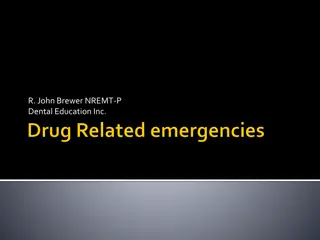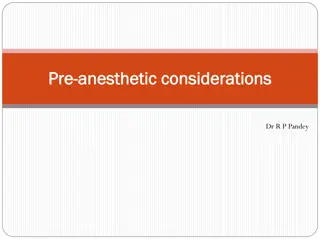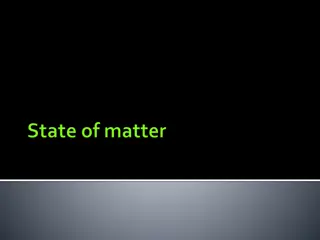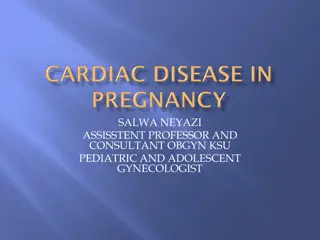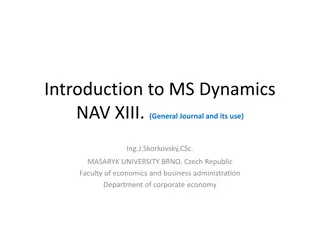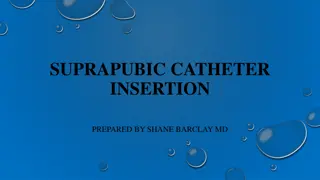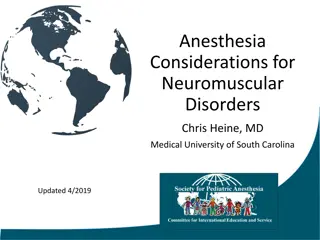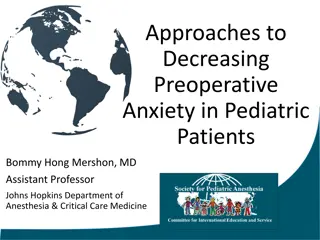Understanding General Anesthetics and Anesthesia
General anesthesia induces a reversible state of CNS depression, providing sedation, amnesia, muscle relaxation, reflex suppression, and analgesia. Preanesthetic medications prepare patients for the process, including antiemetics and anticholinergics. Anesthetics are delivered via inhalation or intravenous methods, with different stages including induction, maintenance, and recovery. Induction involves unconsciousness within seconds, while maintenance monitors vital signs for balance. Overall, general anesthesia plays a crucial role in medical procedures for patient comfort and safety.
Download Presentation

Please find below an Image/Link to download the presentation.
The content on the website is provided AS IS for your information and personal use only. It may not be sold, licensed, or shared on other websites without obtaining consent from the author. Download presentation by click this link. If you encounter any issues during the download, it is possible that the publisher has removed the file from their server.
E N D
Presentation Transcript
General anesthesia is a reversible state of central nervous system (CNS) depression anesthesia provides benefits: 1. Sedation and reduced anxiety. 2. Lack of awareness and amnesia. 3. Skeletal muscle relaxation. 4. Suppression of undesirable reflexes. 5. Analgesia. five important
preanesthetic medications 1. H2 blockers famotidine to reduce gastric acidity. 2. Benzodiazepines (midazolam, diazepam) to reduse anxiety and facilitate amnesia. 3. Nonopioids acetaminophen, celecoxib), opioids (fentanyl) for analgesia.
4. Antiemetics (ondansetron) to prevent nausea. 5. prevent bradycardia and secretion of fluids into the respiratory tract. Anticholinergics (glycopyrrolate) to
general anesthetics are delivered via: inhalation: Nitrous oxide, sevofluran, isofluran, halothane, 2. Intravenous: propofol, Opioids, Benzodiazepines Except for nitrous oxide, inhaled anesthetics are volatile, halogenated hydrocarbons. 1. ketamine,
Stages of general anesthesia General anesthesia has three stages: induction, maintenance, and recovery. 1. Induction is the time from administration of a potent anesthetic to development of effective anesthesia. 2. Maintenance provides anesthesia. 3. Recovery is the time from discontinuation of anesthetic until consciousness sustained
A. Induction General anesthesia in adults is normally induced with an IV agent like propofol, producing unconsciousness in 30 to 40 seconds. Additional inhalation and/or IV drugs may be used. For children without IV access, inhalational agents, such as sevoflurane, are inhaled to induce general anesthesia.
B. Maintenance of anesthesia vital signs and response to stimuli are monitored to balance the amount of drug. Maintenance is commonly provided with volatile anesthetics, control over the depth of anesthesia. which offer good
Opioids such as fentanyl are used for analgesia along with inhalation agents, because the latter are not good analgesics. IV infusions of various drugs may be used during the maintenance phase.
C. Recovery patient consciousness. Redistribution from the site of action (rather than metabolism of the drug) underlies recovery. The patient is monitored to assure full recovery, with normal physiologic functions (spontaneous respiration, acceptable blood pressure and heart rate, intact reflexes). is monitored for return of
Depth of anesthesia 1. Stage experiences analgesia without amnesia. Later in stage I, both analgesia produced. 2. Stage II excitement: During this stage, the patient appears delirious, may vocalize but is completely amnesic.Respiration is rapid, and heart rate and blood pressure increase. I analgesia: The patient initially and amnesia are 3
3. Stage IIIsurgical anesthesia: This stage begins with slowing of respiration and heart rate and extends to complete cessation of spontaneous respiration. 4. Stage IV medullary depression: This deep stage of anesthesia depression of the vasomotor center in respiratory center in the brainstem. Without circulatory and respiratory support, death would rapidly ensue. represents CNS, the severe the and including medulla
Inhalation anesthetics inhalation anesthetics are nonflammable, nonexplosive agents, including nitrous oxide and volatile, halogenated hydrocarbons. Inhaled gases are maintenance of administration of an IV agent. Depth of anesthesia can be rapidly altered by changing the inhaled concentration. used anesthesia primarily for after
Inhalational agents have very steep dose response curves. difference in concentrations causing surgical anesthesia and severe respiratory depression is small. cardiac and
The partial pressure of an anesthetic gas at the respiratory pathway is the driving force moving the anesthetic into the alveolar space and, thence, into the blood (Pa), which delivers the drug to the brain and other body compartments. The time for steady state is determined by anesthetic Solubility in blood which is determined by the coefficient. blood/gas partition
anesthetic with low blood solubility as nitrous oxide diffuses from the alveoli into the circulation, little anesthetic dissolves in the blood. Therefore, equilibrium between inhaled anesthetic and arterial blood occurs rapidly and results in rabid induction.
anesthetic gases with high blood solubility, such as halothane, dissolve more completely in the blood, This results in increased times of induction and recovery and slower changes in depth of anesthesia in response to changes in the concentration.
The solubility in blood is ranked as follows: halothane > isoflurane > sevoflurane > nitrous oxide > desflurane.
Mechanism of action general anesthetics increase the sensitivity of the -aminobutyric acid (GABAA) receptors to the inhibitory neurotransmitter GABA. nitrous oxide and ketamine effects are likely mediated via inhibition of the N-methyl-d- aspartate (NMDA) receptors. The NMDA receptor is a glutamate receptor. Glutamate is the body s main excitatory neurotransmitter.
Halothane its rapid induction and quick recovery made it an anesthetic of choice. Due to adverse effects and the availability of other anesthetics with fewer complications, halothane has been countries. replaced in most
Therapeutic uses: its a potent anesthetic but a weak analgesic. it is usually coadministered with nitrous oxide, opioids. Halothane relaxes both skeletal and uterine muscles and can be used in obstetrics when uterine relaxation is indicated. Halothane is not hepatotoxic in children, Combined with its pleasant odor, it is suitable in pediatrics induction. for inhalation
Pharmacokinetics Halothane hydrocarbons substances that cause toxic reactions that some adults develop after halothane anesthesia. This begins as a fever, followed by anorexia, nausea, and vomiting, and possibly signs of hepatitis. halothane is not administered at intervals of less than 2 to 3 weeks. is metabolized to toxic
Adverse effects a. Cardiac effects: Arrhythmias: as halothane can sensitize the heart to effects of catecholamines such as norepinephrine, hypotension. b. Malignant hyperthermia: a rare life-threatening condition that causes a drastic and uncontrolled increase in skeletal muscle oxidative metabolism, overwhelming the body s capacity to supply oxygen.
Isoflurane little metabolism and is, therefore, not toxic to the liver or kidney. does not induce cardiac arrhythmias or sensitize the heart to catecholamines. it produces dose-dependent hypotension. It has a pungent odor and stimulates respiratory reflexes (for example, breath holding, salivation, therefore not used for inhalation induction. coughing,) and is
Desflurane Desflurane provides very rapid onset and recovery due to low blood solubility. it decreases vascular resistance. Because it stimulates respiratory reflexes, is not used for inhalation induction. Its degradation is minimal and tissue toxicity is rare.
Sevoflurane. Sevoflurane has low pungency, allowing rapid induction without irritating the airways. it suitable for inhalation pediatric patients. It has a rapid onset and recovery due to low blood solubility. Sevoflurane is metabolized by the liver, and compounds formed may be nephrotoxic . induction in
Nitrous oxide Nitrous oxide is a nonirritating potent analgesic but a weak general anesthetic. It is frequently used at concentrations of 30 to 50% in combination with oxygen for analgesia, particularly in dentistry. it is combined with other more potent agents.
In dental practice N2O is now used to provide conscious sedation for allaying anxiety and apprehension. conscious sedation can be employed with local anaesthesia, to carry out dental procedures/surgery children (or adults) and in medically compromised patients. in apprehensive
conscious sedation (a monitored state of altered consciousness) can be employed with local anaesthesia, to procedures/surgery in apprehensive children (or adults) and in medically compromised patients. can be carried out while: 1. maintaining communication patient who is commands 2. maintain a patent airway throughout; therefore, it is safer. carry out dental with the to able to respond
its poor soluble in blood and other tissues, allowing it to move very rapidly in and out of the body Its speed of movement allows nitrous oxide to retard oxygen uptake during recovery, thereby causing diffusion hypoxia, it has moderate to no effect on the cardiovascular system cerebral blood flow, and it is the least hepatotoxic of the Therefore, it is probably the safest of these anesthetics. or on increasing inhalation agents.
2. Intravenous anesthetics cause maintained with an inhalation agent. Recovery from IV anesthetics is due to redistribution from sites in the CNS. the drug diffuses into other tissues with less blood supply. With secondary tissue uptake, predominantly by skeletal muscle, plasma concentration of the drug falls. rapid induction , anesthesia
the drug diffuse out of the CNS, down the resulting reverse concentration gradient. This leads to the rapid recovery seen after a single IV dose of induction agent. Metabolism and plasma clearance become important only following infusions and repeat doses of a drug.
Propofol Propofol is an IV sedative/hypnotic used for induction and/or maintenance of anesthesia. It is widely used and has replaced thiopental as the first choice for induction of general anesthesia and sedation. Induction occurs 30 to 40 seconds after administration. Plasma levels decline rapidly as a result of redistribution,
2. Actions occasionally phenomena, spontaneous movement, yawning. Transient pain at the injection site is common. Propofol decreases blood pressure without depressing the myocardium. It also reduces intracranial pressure, mainly due to systemic vasodilation. accompanied such as muscle twitching, by excitatory
It does not provide analgesia, so supplementation with narcotics is required. Propofol is commonly infused in lower doses to provide sedation. The incidence of postoperative vomiting is very low, as this agent has some antiemetic effects. nausea and
Benzodiazepines The benzodiazepines are used in conjunction with anesthetics for sedation. The most commonly used is midazolam, Diazepam and lorazepam are alternatives. Minimal cardiovascular depressant effects are seen, but all are potential respiratory depressants.
Opioids Because of their analgesic property, opioids are commonly combined with anesthetics. The choice of opioid is based on the duration of action needed. The most commonly used opioids is fentanyl analgesia more rapid than morphine. they can all cause hypotension, respiratory depression, and muscle rigidity, as well as postanesthetic nausea and vomiting.
Ketamine Ketamine a short-acting, anesthetic, induces a dissociated state in which the patient is unconscious (but may appear to be awake) and does not feel pain. dissociative anesthesia provides sedation, amnesia, and immobility. Ketamine causing stimulation of the heart with increased blood pressure and CO.
It is also a potent bronchodilator. Therefore, it is beneficial in patients with hypovolemic or cardiogenic shock and in asthmatics. Ketamine is used mainly in children and elderly adults for short procedures. It is not widely used, because it increases cerebral blood flow and may induce hallucinations, particularly in young adults.
Etomidate Etomidate is a hypnotic agent used to induce anesthesia, but it lacks analgesic activity. Induction is rapid, and the drug is short- acting. Among its benefits are little to no effect on the heart and circulation. used for patients with coronary artery disease or cardiovascular dysfunction. Its adverse effects include decreased plasma cortisol and aldosterone levels, which can persist up to 8 hours.


